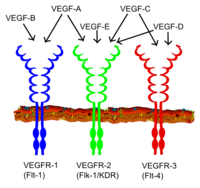
Photo from wikipedia
Phosphorylation is an essential process in biological events and is considered critical for biological functions. In tissues, protein phosphorylation mainly occurs on tyrosine (Tyr), serine (Ser) and threonine (Thr) residues.… Click to show full abstract
Phosphorylation is an essential process in biological events and is considered critical for biological functions. In tissues, protein phosphorylation mainly occurs on tyrosine (Tyr), serine (Ser) and threonine (Thr) residues. The balance between phosphorylation and dephosphorylation is under the control of two super enzyme families, protein kinases (PKs) and protein phosphatases (PPs), respectively. Although there are many selective and effective drugs targeting phosphokinases, developing drugs targeting phosphatases is challenging. PTP1B, one of the most central protein tyrosine phosphatases (PTPs), is a key player in several human diseases and disorders, such as diabetes, obesity, and hematopoietic malignancies, through modulation of different signaling pathways. However, due to high conservation among PTPs, most PTP1B inhibitors lack specificity, raising the need to develop new strategies targeting this enzyme. In this mini-review, we summarize three classes of PTP1B inhibitors with different mechanisms: (1) targeting multiple aryl-phosphorylation sites including the catalytic site of PTP1B; (2) targeting allosteric sites of PTP1B; (3) targeting specific mRNA sequence of PTP1B. All three types of PTP1B inhibitors present good specificity over other PTPs and are promising for the development of efficient small molecules targeting this enzyme.
Journal Title: International Journal of Molecular Sciences
Year Published: 2022
Link to full text (if available)
Share on Social Media: Sign Up to like & get
recommendations!